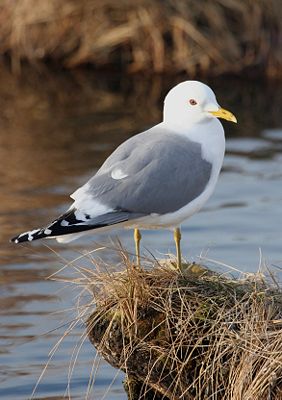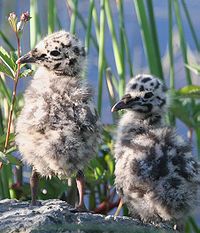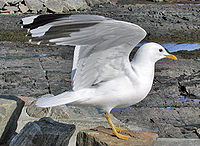- Larus canus
-
Sturmmöwe Systematik Ordnung: Regenpfeiferartige (Charadriiformes) Familie: Möwen (Laridae) Gattung: Larus Art: Sturmmöwe Wissenschaftlicher Name Larus canus Linnaeus, 1758 Die Sturmmöwe (Larus canus) ist eine Vogelart aus der Familie der Möwen (Laridae).
Inhaltsverzeichnis
Beschreibung
Eine ausgewachsene Sturmmöwe sieht der Dreizehenmöwe sehr ähnlich, wird bis 43 cm groß und erreicht eine Flügelspannweite von etwa 120 cm. Sie wiegt 300 bis 550 g. Ihr Gefieder ist weiß und die Oberseite der Flügel grau gefärbt. Die Flügelspitzen sind schwarzweiß, der Schnabel und die Beine grüngelb gefärbt. Die Jungen haben erst nach dem dritten Lebensjahr diese Färbung. Männchen und Weibchen unterscheiden sich nicht in ihrem Gefieder. Eine Sturmmöwe kann bis 25 Jahre alt werden. Ihr Ruf klingt in etwa wie "kiäh" oder "kiah".
Lebensraum
Die Sturmmöwe lebt hauptsächlich an Küsten und nur selten an Binnengewässern. Sie ist in Nord- und Mitteleuropa gut verbreitet. Manche Sturmmöwen verbringen den Winter im Binnenland oder ziehen nach Südeuropa bis Nordafrika.
Ernährung
Auf dem Speiseplan der Sturmmöwe stehen hauptsächlich Fische. Außerdem ernährt sie sich von Würmern, Insekten, Pflanzenteilen und Abfällen. Wie die Lachmöwe sucht sie auf Müllkippen, Grünflächen und Äckern nach allem, was den Hunger stillt.
Fortpflanzung
Die Geschlechtsreife tritt nach drei Jahren ein. Die Brutzeit erstreckt sich von Mai bis Juli. Die Sturmmöwe brütet in Kolonien in der Nähe von Gewässern. Das Nest wird auf einem vegetationsarmen, trockenen Boden erbaut, so behalten die Eltern den Überblick. Der Abstand von einem Nest zum anderen kann 5 bis 20 m sein. Das Weibchen legt meist drei Eier in das aus Pflanzenteilen erbaute Nest. Beide Eltern wärmen die Eier 23 bis 28 Tage lang, bis die Jungen schlüpfen. Nach vier bis fünf Wochen werden die Jungvögel flügge.
Weblinks
- Larus canus in der Roten Liste gefährdeter Arten der IUCN 2008. Eingestellt von: BirdLife International, 2008. Abgerufen am 31. Januar 2009
- Videos, Fotos und Tonaufnahmen zu Larus canus in der Internet Bird Collection
Wikimedia Foundation.



